Organisational Development and Change Report: Woolworths Analysis
VerifiedAdded on 2023/01/20
|12
|3437
|25
Report
AI Summary
This report provides a detailed analysis of Woolworths' organizational development and change readiness. It begins by examining the company's strategic mission, goals, and change initiatives, emphasizing the alignment of these initiatives with its strategic objectives. The report then delves into Woolworths' organizational culture, utilizing the Hofstede model to assess its dimensions and their impact on change readiness. Furthermore, it explores the importance of stakeholder identification and management in implementing change initiatives, as well as the identification of potential resistance to change. The report concludes with key findings that determine the level of change readiness within Woolworths, offering insights into the company's ability to adapt and thrive in a dynamic business environment. The report highlights the importance of internal and external views of strategy, organizational structure, and value proposition in assessing change readiness.
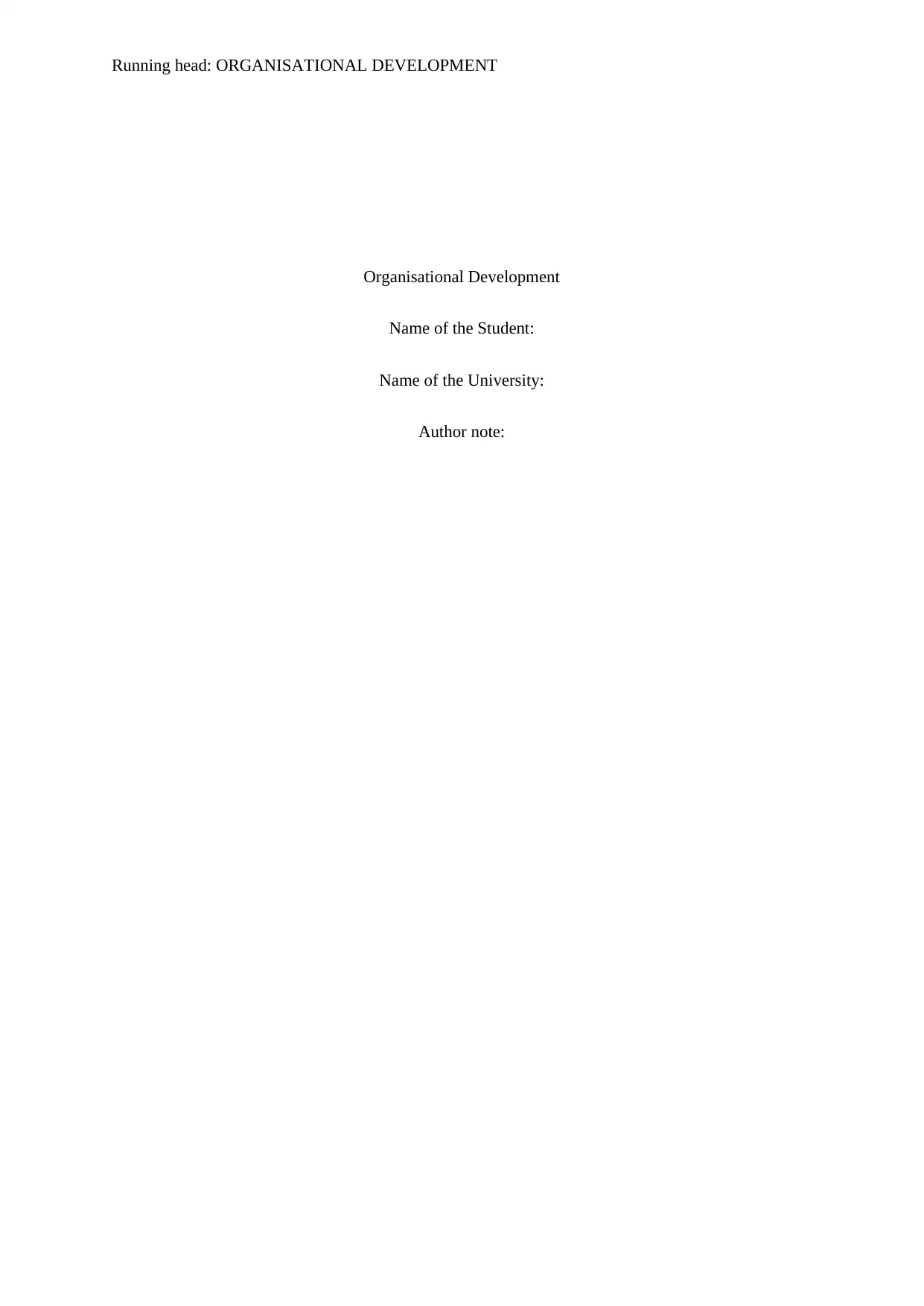
Running head: ORGANISATIONAL DEVELOPMENT
Organisational Development
Name of the Student:
Name of the University:
Author note:
Organisational Development
Name of the Student:
Name of the University:
Author note:
Paraphrase This Document
Need a fresh take? Get an instant paraphrase of this document with our AI Paraphraser
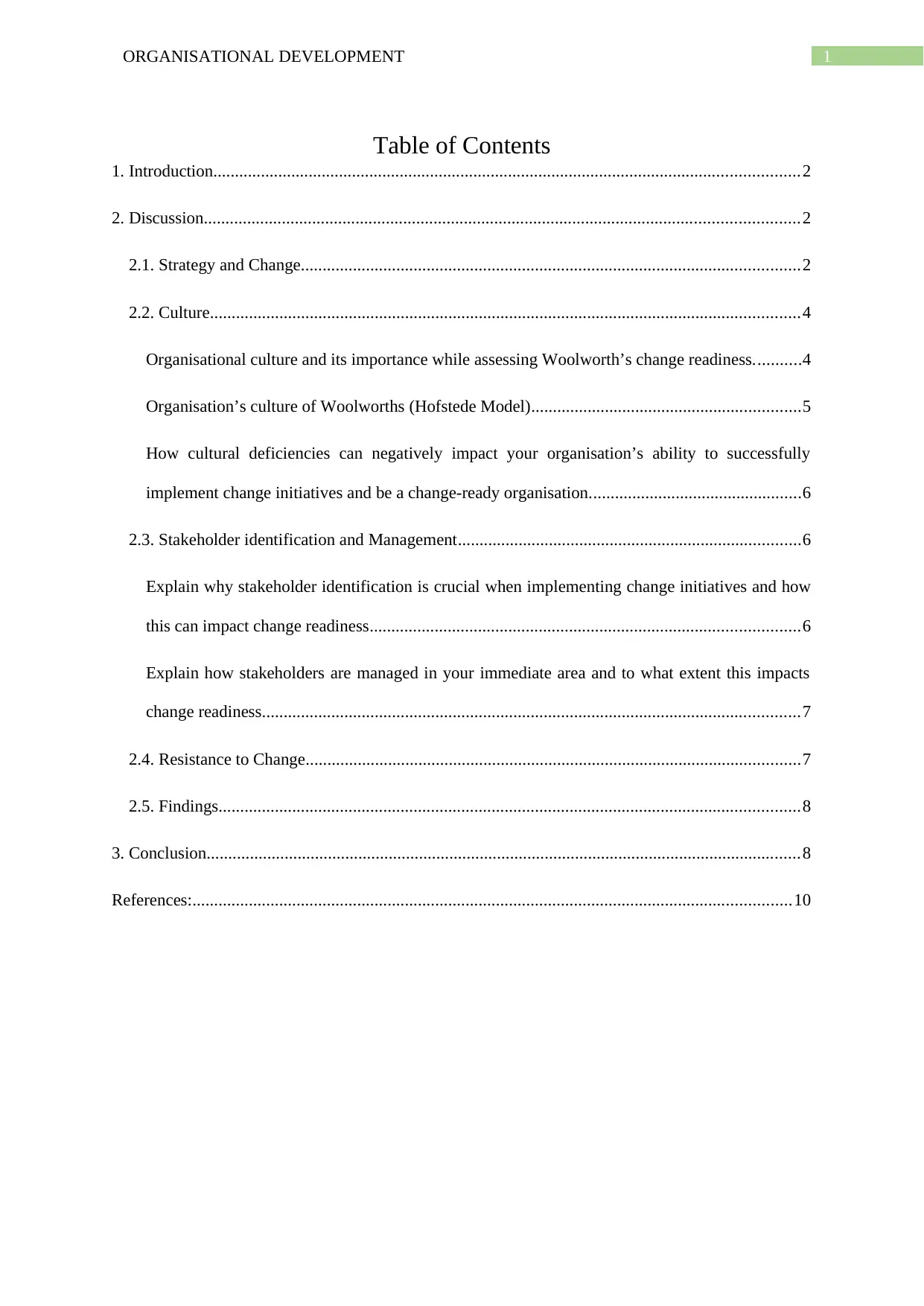
1ORGANISATIONAL DEVELOPMENT
Table of Contents
1. Introduction.......................................................................................................................................2
2. Discussion.........................................................................................................................................2
2.1. Strategy and Change...................................................................................................................2
2.2. Culture........................................................................................................................................4
Organisational culture and its importance while assessing Woolworth’s change readiness...........4
Organisation’s culture of Woolworths (Hofstede Model)..............................................................5
How cultural deficiencies can negatively impact your organisation’s ability to successfully
implement change initiatives and be a change-ready organisation.................................................6
2.3. Stakeholder identification and Management...............................................................................6
Explain why stakeholder identification is crucial when implementing change initiatives and how
this can impact change readiness...................................................................................................6
Explain how stakeholders are managed in your immediate area and to what extent this impacts
change readiness............................................................................................................................7
2.4. Resistance to Change..................................................................................................................7
2.5. Findings......................................................................................................................................8
3. Conclusion.........................................................................................................................................8
References:..........................................................................................................................................10
Table of Contents
1. Introduction.......................................................................................................................................2
2. Discussion.........................................................................................................................................2
2.1. Strategy and Change...................................................................................................................2
2.2. Culture........................................................................................................................................4
Organisational culture and its importance while assessing Woolworth’s change readiness...........4
Organisation’s culture of Woolworths (Hofstede Model)..............................................................5
How cultural deficiencies can negatively impact your organisation’s ability to successfully
implement change initiatives and be a change-ready organisation.................................................6
2.3. Stakeholder identification and Management...............................................................................6
Explain why stakeholder identification is crucial when implementing change initiatives and how
this can impact change readiness...................................................................................................6
Explain how stakeholders are managed in your immediate area and to what extent this impacts
change readiness............................................................................................................................7
2.4. Resistance to Change..................................................................................................................7
2.5. Findings......................................................................................................................................8
3. Conclusion.........................................................................................................................................8
References:..........................................................................................................................................10
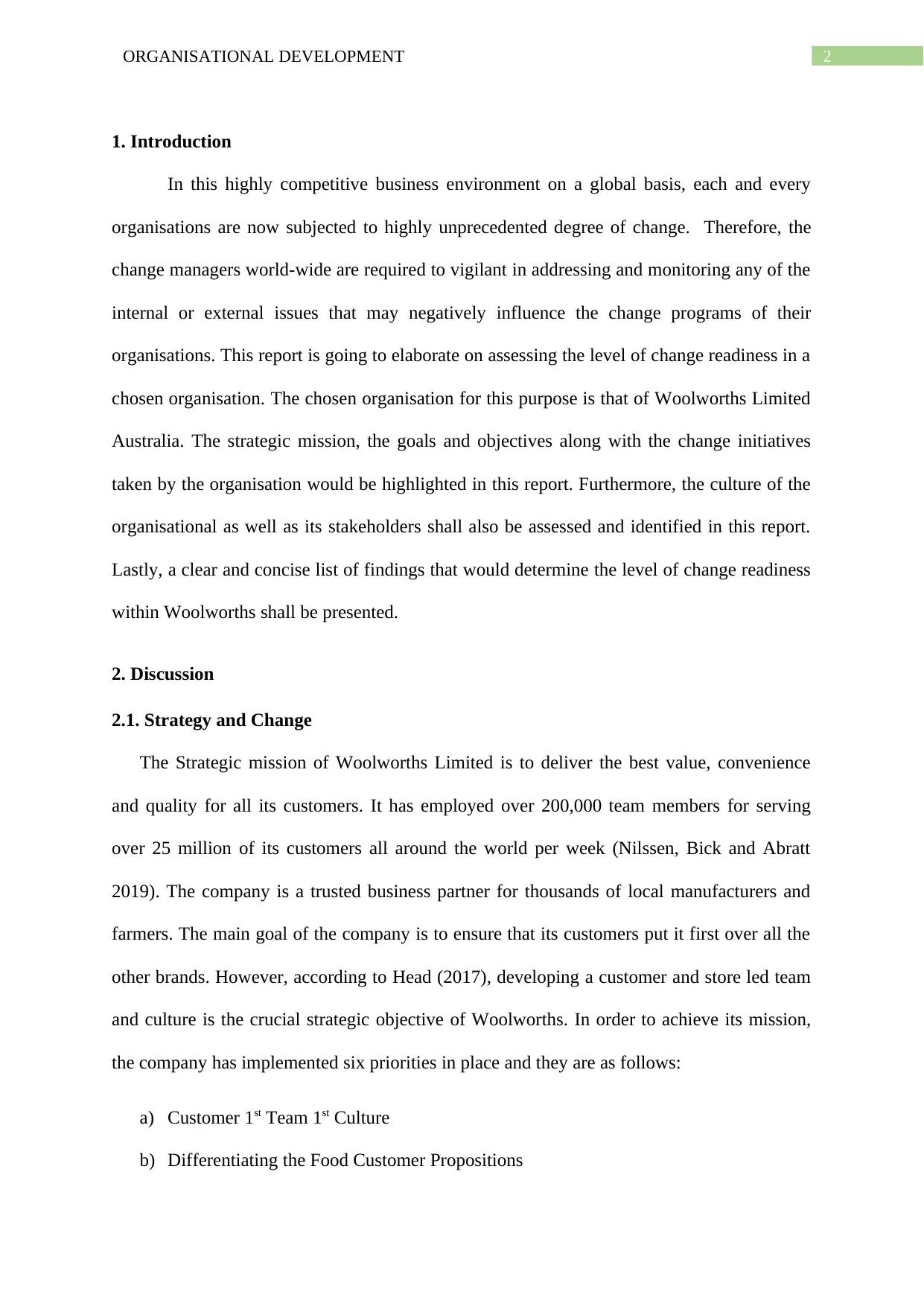
2ORGANISATIONAL DEVELOPMENT
1. Introduction
In this highly competitive business environment on a global basis, each and every
organisations are now subjected to highly unprecedented degree of change. Therefore, the
change managers world-wide are required to vigilant in addressing and monitoring any of the
internal or external issues that may negatively influence the change programs of their
organisations. This report is going to elaborate on assessing the level of change readiness in a
chosen organisation. The chosen organisation for this purpose is that of Woolworths Limited
Australia. The strategic mission, the goals and objectives along with the change initiatives
taken by the organisation would be highlighted in this report. Furthermore, the culture of the
organisational as well as its stakeholders shall also be assessed and identified in this report.
Lastly, a clear and concise list of findings that would determine the level of change readiness
within Woolworths shall be presented.
2. Discussion
2.1. Strategy and Change
The Strategic mission of Woolworths Limited is to deliver the best value, convenience
and quality for all its customers. It has employed over 200,000 team members for serving
over 25 million of its customers all around the world per week (Nilssen, Bick and Abratt
2019). The company is a trusted business partner for thousands of local manufacturers and
farmers. The main goal of the company is to ensure that its customers put it first over all the
other brands. However, according to Head (2017), developing a customer and store led team
and culture is the crucial strategic objective of Woolworths. In order to achieve its mission,
the company has implemented six priorities in place and they are as follows:
a) Customer 1st Team 1st Culture
b) Differentiating the Food Customer Propositions
1. Introduction
In this highly competitive business environment on a global basis, each and every
organisations are now subjected to highly unprecedented degree of change. Therefore, the
change managers world-wide are required to vigilant in addressing and monitoring any of the
internal or external issues that may negatively influence the change programs of their
organisations. This report is going to elaborate on assessing the level of change readiness in a
chosen organisation. The chosen organisation for this purpose is that of Woolworths Limited
Australia. The strategic mission, the goals and objectives along with the change initiatives
taken by the organisation would be highlighted in this report. Furthermore, the culture of the
organisational as well as its stakeholders shall also be assessed and identified in this report.
Lastly, a clear and concise list of findings that would determine the level of change readiness
within Woolworths shall be presented.
2. Discussion
2.1. Strategy and Change
The Strategic mission of Woolworths Limited is to deliver the best value, convenience
and quality for all its customers. It has employed over 200,000 team members for serving
over 25 million of its customers all around the world per week (Nilssen, Bick and Abratt
2019). The company is a trusted business partner for thousands of local manufacturers and
farmers. The main goal of the company is to ensure that its customers put it first over all the
other brands. However, according to Head (2017), developing a customer and store led team
and culture is the crucial strategic objective of Woolworths. In order to achieve its mission,
the company has implemented six priorities in place and they are as follows:
a) Customer 1st Team 1st Culture
b) Differentiating the Food Customer Propositions
⊘ This is a preview!⊘
Do you want full access?
Subscribe today to unlock all pages.

Trusted by 1+ million students worldwide
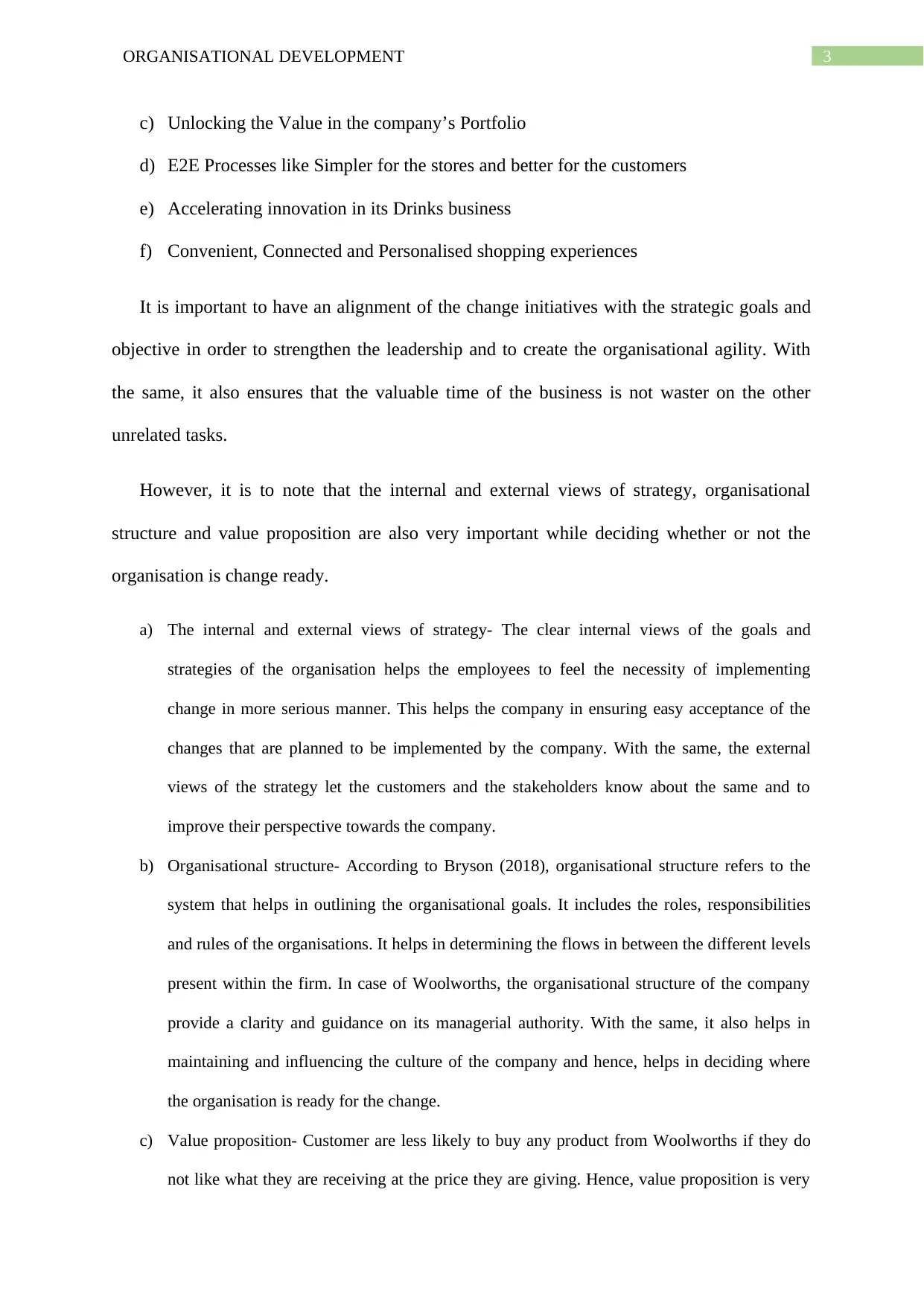
3ORGANISATIONAL DEVELOPMENT
c) Unlocking the Value in the company’s Portfolio
d) E2E Processes like Simpler for the stores and better for the customers
e) Accelerating innovation in its Drinks business
f) Convenient, Connected and Personalised shopping experiences
It is important to have an alignment of the change initiatives with the strategic goals and
objective in order to strengthen the leadership and to create the organisational agility. With
the same, it also ensures that the valuable time of the business is not waster on the other
unrelated tasks.
However, it is to note that the internal and external views of strategy, organisational
structure and value proposition are also very important while deciding whether or not the
organisation is change ready.
a) The internal and external views of strategy- The clear internal views of the goals and
strategies of the organisation helps the employees to feel the necessity of implementing
change in more serious manner. This helps the company in ensuring easy acceptance of the
changes that are planned to be implemented by the company. With the same, the external
views of the strategy let the customers and the stakeholders know about the same and to
improve their perspective towards the company.
b) Organisational structure- According to Bryson (2018), organisational structure refers to the
system that helps in outlining the organisational goals. It includes the roles, responsibilities
and rules of the organisations. It helps in determining the flows in between the different levels
present within the firm. In case of Woolworths, the organisational structure of the company
provide a clarity and guidance on its managerial authority. With the same, it also helps in
maintaining and influencing the culture of the company and hence, helps in deciding where
the organisation is ready for the change.
c) Value proposition- Customer are less likely to buy any product from Woolworths if they do
not like what they are receiving at the price they are giving. Hence, value proposition is very
c) Unlocking the Value in the company’s Portfolio
d) E2E Processes like Simpler for the stores and better for the customers
e) Accelerating innovation in its Drinks business
f) Convenient, Connected and Personalised shopping experiences
It is important to have an alignment of the change initiatives with the strategic goals and
objective in order to strengthen the leadership and to create the organisational agility. With
the same, it also ensures that the valuable time of the business is not waster on the other
unrelated tasks.
However, it is to note that the internal and external views of strategy, organisational
structure and value proposition are also very important while deciding whether or not the
organisation is change ready.
a) The internal and external views of strategy- The clear internal views of the goals and
strategies of the organisation helps the employees to feel the necessity of implementing
change in more serious manner. This helps the company in ensuring easy acceptance of the
changes that are planned to be implemented by the company. With the same, the external
views of the strategy let the customers and the stakeholders know about the same and to
improve their perspective towards the company.
b) Organisational structure- According to Bryson (2018), organisational structure refers to the
system that helps in outlining the organisational goals. It includes the roles, responsibilities
and rules of the organisations. It helps in determining the flows in between the different levels
present within the firm. In case of Woolworths, the organisational structure of the company
provide a clarity and guidance on its managerial authority. With the same, it also helps in
maintaining and influencing the culture of the company and hence, helps in deciding where
the organisation is ready for the change.
c) Value proposition- Customer are less likely to buy any product from Woolworths if they do
not like what they are receiving at the price they are giving. Hence, value proposition is very
Paraphrase This Document
Need a fresh take? Get an instant paraphrase of this document with our AI Paraphraser
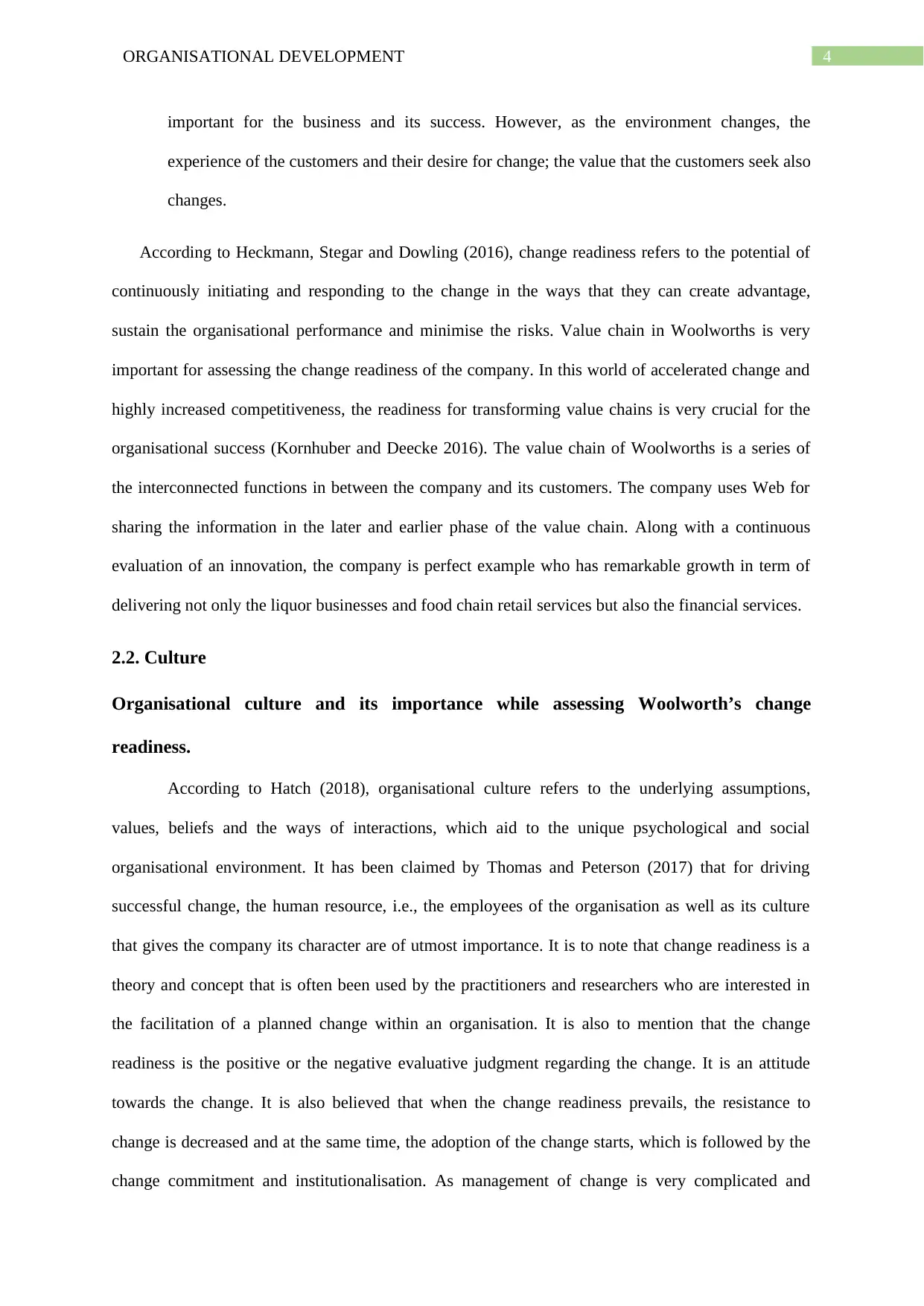
4ORGANISATIONAL DEVELOPMENT
important for the business and its success. However, as the environment changes, the
experience of the customers and their desire for change; the value that the customers seek also
changes.
According to Heckmann, Stegar and Dowling (2016), change readiness refers to the potential of
continuously initiating and responding to the change in the ways that they can create advantage,
sustain the organisational performance and minimise the risks. Value chain in Woolworths is very
important for assessing the change readiness of the company. In this world of accelerated change and
highly increased competitiveness, the readiness for transforming value chains is very crucial for the
organisational success (Kornhuber and Deecke 2016). The value chain of Woolworths is a series of
the interconnected functions in between the company and its customers. The company uses Web for
sharing the information in the later and earlier phase of the value chain. Along with a continuous
evaluation of an innovation, the company is perfect example who has remarkable growth in term of
delivering not only the liquor businesses and food chain retail services but also the financial services.
2.2. Culture
Organisational culture and its importance while assessing Woolworth’s change
readiness.
According to Hatch (2018), organisational culture refers to the underlying assumptions,
values, beliefs and the ways of interactions, which aid to the unique psychological and social
organisational environment. It has been claimed by Thomas and Peterson (2017) that for driving
successful change, the human resource, i.e., the employees of the organisation as well as its culture
that gives the company its character are of utmost importance. It is to note that change readiness is a
theory and concept that is often been used by the practitioners and researchers who are interested in
the facilitation of a planned change within an organisation. It is also to mention that the change
readiness is the positive or the negative evaluative judgment regarding the change. It is an attitude
towards the change. It is also believed that when the change readiness prevails, the resistance to
change is decreased and at the same time, the adoption of the change starts, which is followed by the
change commitment and institutionalisation. As management of change is very complicated and
important for the business and its success. However, as the environment changes, the
experience of the customers and their desire for change; the value that the customers seek also
changes.
According to Heckmann, Stegar and Dowling (2016), change readiness refers to the potential of
continuously initiating and responding to the change in the ways that they can create advantage,
sustain the organisational performance and minimise the risks. Value chain in Woolworths is very
important for assessing the change readiness of the company. In this world of accelerated change and
highly increased competitiveness, the readiness for transforming value chains is very crucial for the
organisational success (Kornhuber and Deecke 2016). The value chain of Woolworths is a series of
the interconnected functions in between the company and its customers. The company uses Web for
sharing the information in the later and earlier phase of the value chain. Along with a continuous
evaluation of an innovation, the company is perfect example who has remarkable growth in term of
delivering not only the liquor businesses and food chain retail services but also the financial services.
2.2. Culture
Organisational culture and its importance while assessing Woolworth’s change
readiness.
According to Hatch (2018), organisational culture refers to the underlying assumptions,
values, beliefs and the ways of interactions, which aid to the unique psychological and social
organisational environment. It has been claimed by Thomas and Peterson (2017) that for driving
successful change, the human resource, i.e., the employees of the organisation as well as its culture
that gives the company its character are of utmost importance. It is to note that change readiness is a
theory and concept that is often been used by the practitioners and researchers who are interested in
the facilitation of a planned change within an organisation. It is also to mention that the change
readiness is the positive or the negative evaluative judgment regarding the change. It is an attitude
towards the change. It is also believed that when the change readiness prevails, the resistance to
change is decreased and at the same time, the adoption of the change starts, which is followed by the
change commitment and institutionalisation. As management of change is very complicated and
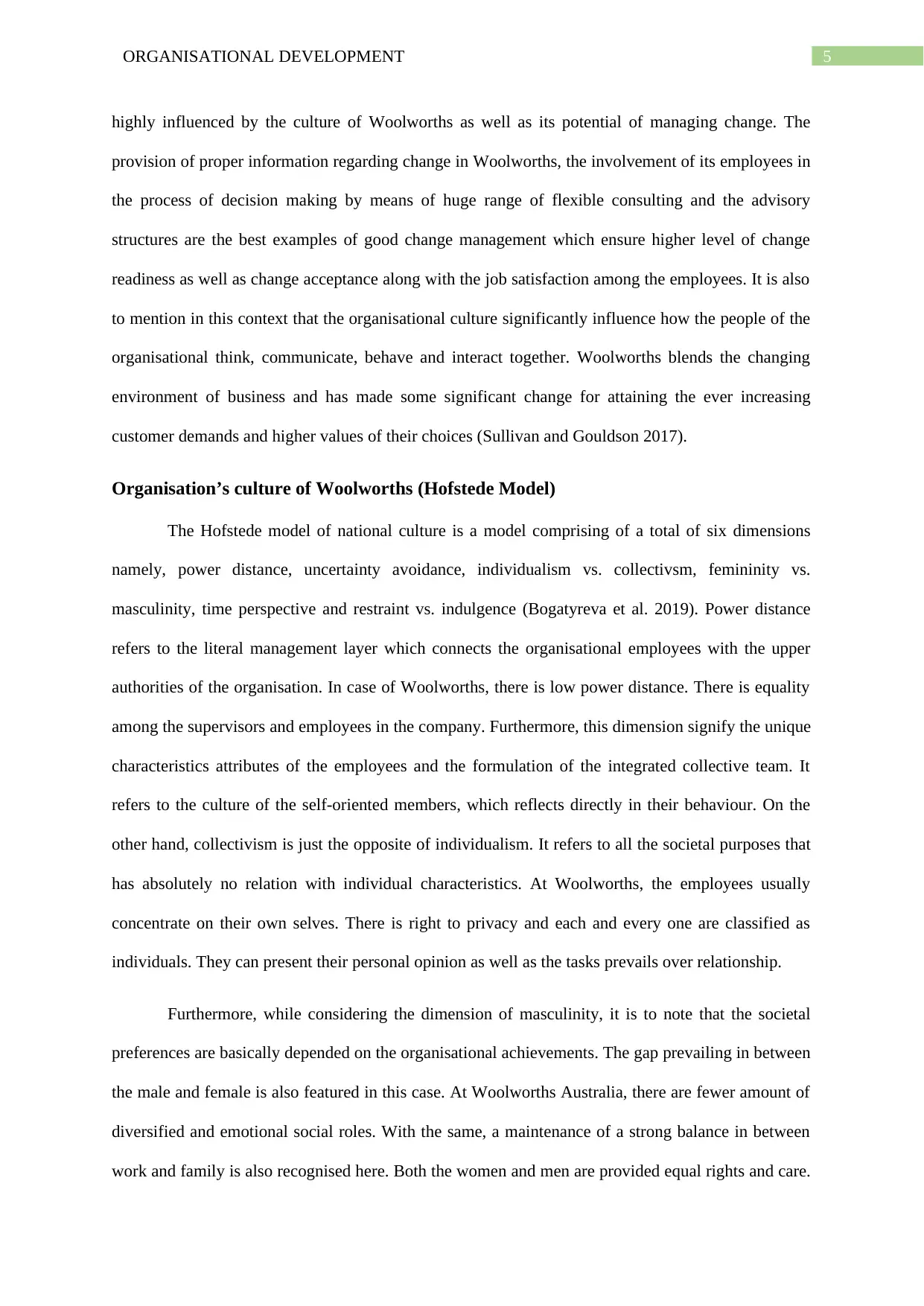
5ORGANISATIONAL DEVELOPMENT
highly influenced by the culture of Woolworths as well as its potential of managing change. The
provision of proper information regarding change in Woolworths, the involvement of its employees in
the process of decision making by means of huge range of flexible consulting and the advisory
structures are the best examples of good change management which ensure higher level of change
readiness as well as change acceptance along with the job satisfaction among the employees. It is also
to mention in this context that the organisational culture significantly influence how the people of the
organisational think, communicate, behave and interact together. Woolworths blends the changing
environment of business and has made some significant change for attaining the ever increasing
customer demands and higher values of their choices (Sullivan and Gouldson 2017).
Organisation’s culture of Woolworths (Hofstede Model)
The Hofstede model of national culture is a model comprising of a total of six dimensions
namely, power distance, uncertainty avoidance, individualism vs. collectivsm, femininity vs.
masculinity, time perspective and restraint vs. indulgence (Bogatyreva et al. 2019). Power distance
refers to the literal management layer which connects the organisational employees with the upper
authorities of the organisation. In case of Woolworths, there is low power distance. There is equality
among the supervisors and employees in the company. Furthermore, this dimension signify the unique
characteristics attributes of the employees and the formulation of the integrated collective team. It
refers to the culture of the self-oriented members, which reflects directly in their behaviour. On the
other hand, collectivism is just the opposite of individualism. It refers to all the societal purposes that
has absolutely no relation with individual characteristics. At Woolworths, the employees usually
concentrate on their own selves. There is right to privacy and each and every one are classified as
individuals. They can present their personal opinion as well as the tasks prevails over relationship.
Furthermore, while considering the dimension of masculinity, it is to note that the societal
preferences are basically depended on the organisational achievements. The gap prevailing in between
the male and female is also featured in this case. At Woolworths Australia, there are fewer amount of
diversified and emotional social roles. With the same, a maintenance of a strong balance in between
work and family is also recognised here. Both the women and men are provided equal rights and care.
highly influenced by the culture of Woolworths as well as its potential of managing change. The
provision of proper information regarding change in Woolworths, the involvement of its employees in
the process of decision making by means of huge range of flexible consulting and the advisory
structures are the best examples of good change management which ensure higher level of change
readiness as well as change acceptance along with the job satisfaction among the employees. It is also
to mention in this context that the organisational culture significantly influence how the people of the
organisational think, communicate, behave and interact together. Woolworths blends the changing
environment of business and has made some significant change for attaining the ever increasing
customer demands and higher values of their choices (Sullivan and Gouldson 2017).
Organisation’s culture of Woolworths (Hofstede Model)
The Hofstede model of national culture is a model comprising of a total of six dimensions
namely, power distance, uncertainty avoidance, individualism vs. collectivsm, femininity vs.
masculinity, time perspective and restraint vs. indulgence (Bogatyreva et al. 2019). Power distance
refers to the literal management layer which connects the organisational employees with the upper
authorities of the organisation. In case of Woolworths, there is low power distance. There is equality
among the supervisors and employees in the company. Furthermore, this dimension signify the unique
characteristics attributes of the employees and the formulation of the integrated collective team. It
refers to the culture of the self-oriented members, which reflects directly in their behaviour. On the
other hand, collectivism is just the opposite of individualism. It refers to all the societal purposes that
has absolutely no relation with individual characteristics. At Woolworths, the employees usually
concentrate on their own selves. There is right to privacy and each and every one are classified as
individuals. They can present their personal opinion as well as the tasks prevails over relationship.
Furthermore, while considering the dimension of masculinity, it is to note that the societal
preferences are basically depended on the organisational achievements. The gap prevailing in between
the male and female is also featured in this case. At Woolworths Australia, there are fewer amount of
diversified and emotional social roles. With the same, a maintenance of a strong balance in between
work and family is also recognised here. Both the women and men are provided equal rights and care.
⊘ This is a preview!⊘
Do you want full access?
Subscribe today to unlock all pages.

Trusted by 1+ million students worldwide
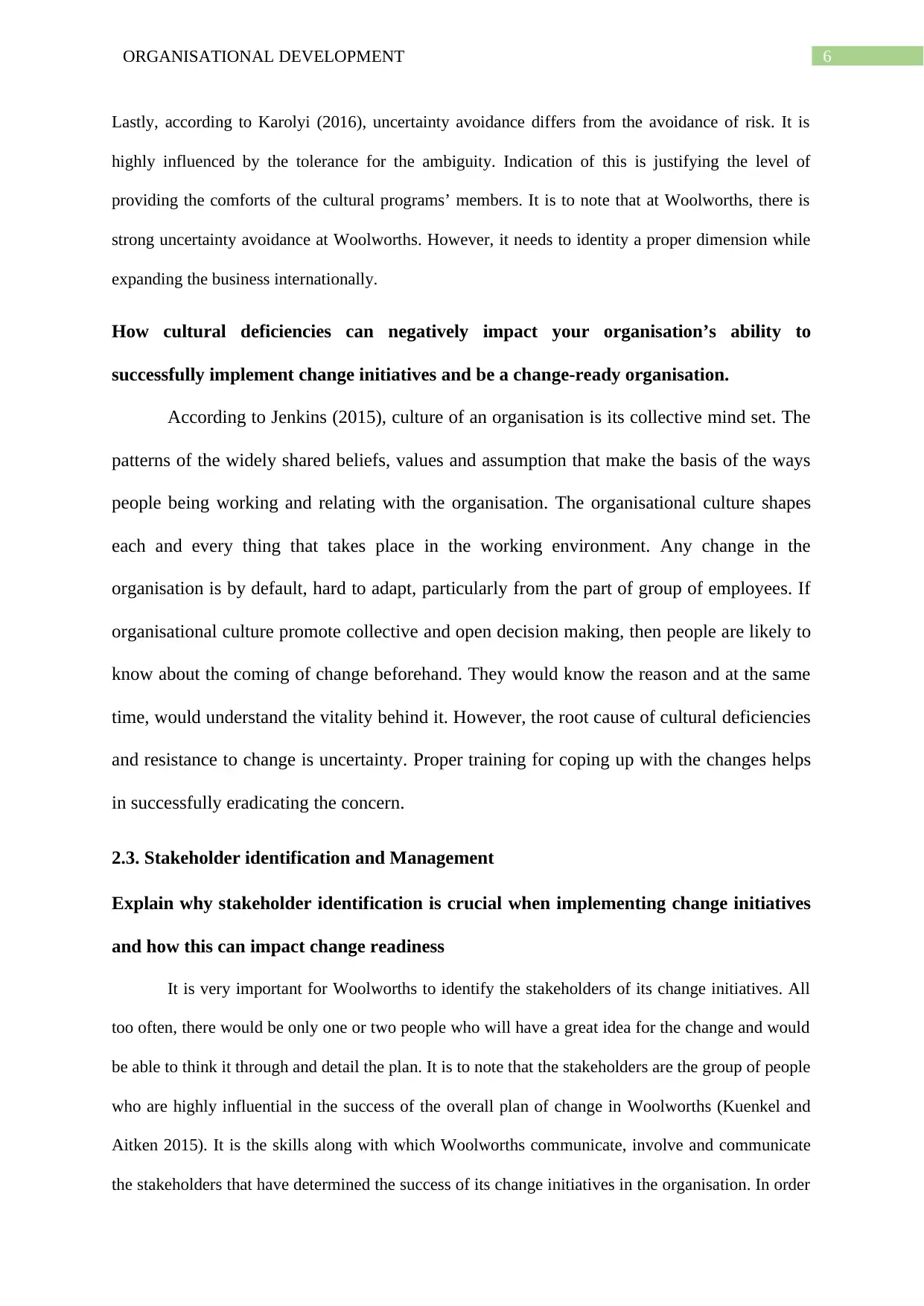
6ORGANISATIONAL DEVELOPMENT
Lastly, according to Karolyi (2016), uncertainty avoidance differs from the avoidance of risk. It is
highly influenced by the tolerance for the ambiguity. Indication of this is justifying the level of
providing the comforts of the cultural programs’ members. It is to note that at Woolworths, there is
strong uncertainty avoidance at Woolworths. However, it needs to identity a proper dimension while
expanding the business internationally.
How cultural deficiencies can negatively impact your organisation’s ability to
successfully implement change initiatives and be a change-ready organisation.
According to Jenkins (2015), culture of an organisation is its collective mind set. The
patterns of the widely shared beliefs, values and assumption that make the basis of the ways
people being working and relating with the organisation. The organisational culture shapes
each and every thing that takes place in the working environment. Any change in the
organisation is by default, hard to adapt, particularly from the part of group of employees. If
organisational culture promote collective and open decision making, then people are likely to
know about the coming of change beforehand. They would know the reason and at the same
time, would understand the vitality behind it. However, the root cause of cultural deficiencies
and resistance to change is uncertainty. Proper training for coping up with the changes helps
in successfully eradicating the concern.
2.3. Stakeholder identification and Management
Explain why stakeholder identification is crucial when implementing change initiatives
and how this can impact change readiness
It is very important for Woolworths to identify the stakeholders of its change initiatives. All
too often, there would be only one or two people who will have a great idea for the change and would
be able to think it through and detail the plan. It is to note that the stakeholders are the group of people
who are highly influential in the success of the overall plan of change in Woolworths (Kuenkel and
Aitken 2015). It is the skills along with which Woolworths communicate, involve and communicate
the stakeholders that have determined the success of its change initiatives in the organisation. In order
Lastly, according to Karolyi (2016), uncertainty avoidance differs from the avoidance of risk. It is
highly influenced by the tolerance for the ambiguity. Indication of this is justifying the level of
providing the comforts of the cultural programs’ members. It is to note that at Woolworths, there is
strong uncertainty avoidance at Woolworths. However, it needs to identity a proper dimension while
expanding the business internationally.
How cultural deficiencies can negatively impact your organisation’s ability to
successfully implement change initiatives and be a change-ready organisation.
According to Jenkins (2015), culture of an organisation is its collective mind set. The
patterns of the widely shared beliefs, values and assumption that make the basis of the ways
people being working and relating with the organisation. The organisational culture shapes
each and every thing that takes place in the working environment. Any change in the
organisation is by default, hard to adapt, particularly from the part of group of employees. If
organisational culture promote collective and open decision making, then people are likely to
know about the coming of change beforehand. They would know the reason and at the same
time, would understand the vitality behind it. However, the root cause of cultural deficiencies
and resistance to change is uncertainty. Proper training for coping up with the changes helps
in successfully eradicating the concern.
2.3. Stakeholder identification and Management
Explain why stakeholder identification is crucial when implementing change initiatives
and how this can impact change readiness
It is very important for Woolworths to identify the stakeholders of its change initiatives. All
too often, there would be only one or two people who will have a great idea for the change and would
be able to think it through and detail the plan. It is to note that the stakeholders are the group of people
who are highly influential in the success of the overall plan of change in Woolworths (Kuenkel and
Aitken 2015). It is the skills along with which Woolworths communicate, involve and communicate
the stakeholders that have determined the success of its change initiatives in the organisation. In order
Paraphrase This Document
Need a fresh take? Get an instant paraphrase of this document with our AI Paraphraser
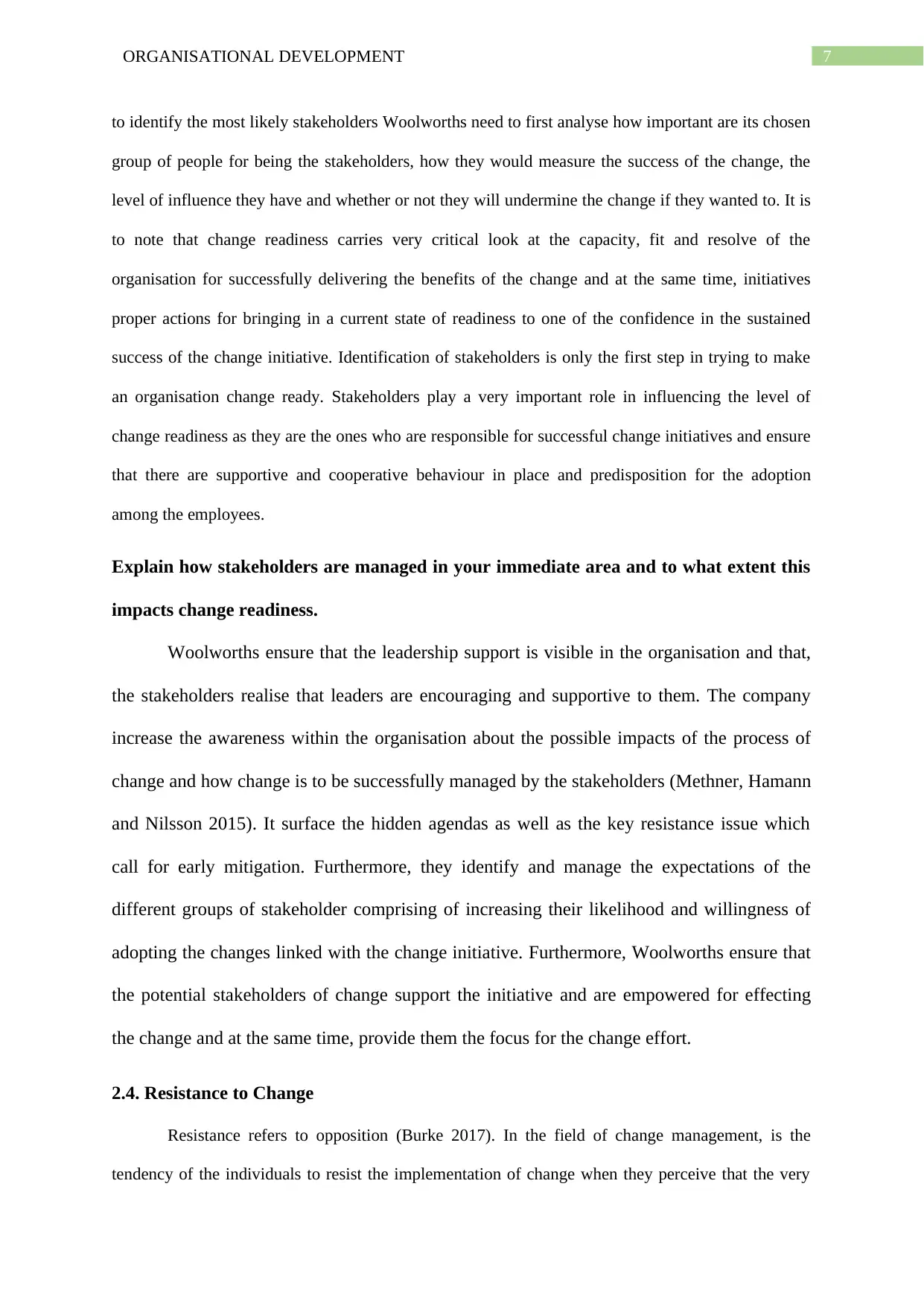
7ORGANISATIONAL DEVELOPMENT
to identify the most likely stakeholders Woolworths need to first analyse how important are its chosen
group of people for being the stakeholders, how they would measure the success of the change, the
level of influence they have and whether or not they will undermine the change if they wanted to. It is
to note that change readiness carries very critical look at the capacity, fit and resolve of the
organisation for successfully delivering the benefits of the change and at the same time, initiatives
proper actions for bringing in a current state of readiness to one of the confidence in the sustained
success of the change initiative. Identification of stakeholders is only the first step in trying to make
an organisation change ready. Stakeholders play a very important role in influencing the level of
change readiness as they are the ones who are responsible for successful change initiatives and ensure
that there are supportive and cooperative behaviour in place and predisposition for the adoption
among the employees.
Explain how stakeholders are managed in your immediate area and to what extent this
impacts change readiness.
Woolworths ensure that the leadership support is visible in the organisation and that,
the stakeholders realise that leaders are encouraging and supportive to them. The company
increase the awareness within the organisation about the possible impacts of the process of
change and how change is to be successfully managed by the stakeholders (Methner, Hamann
and Nilsson 2015). It surface the hidden agendas as well as the key resistance issue which
call for early mitigation. Furthermore, they identify and manage the expectations of the
different groups of stakeholder comprising of increasing their likelihood and willingness of
adopting the changes linked with the change initiative. Furthermore, Woolworths ensure that
the potential stakeholders of change support the initiative and are empowered for effecting
the change and at the same time, provide them the focus for the change effort.
2.4. Resistance to Change
Resistance refers to opposition (Burke 2017). In the field of change management, is the
tendency of the individuals to resist the implementation of change when they perceive that the very
to identify the most likely stakeholders Woolworths need to first analyse how important are its chosen
group of people for being the stakeholders, how they would measure the success of the change, the
level of influence they have and whether or not they will undermine the change if they wanted to. It is
to note that change readiness carries very critical look at the capacity, fit and resolve of the
organisation for successfully delivering the benefits of the change and at the same time, initiatives
proper actions for bringing in a current state of readiness to one of the confidence in the sustained
success of the change initiative. Identification of stakeholders is only the first step in trying to make
an organisation change ready. Stakeholders play a very important role in influencing the level of
change readiness as they are the ones who are responsible for successful change initiatives and ensure
that there are supportive and cooperative behaviour in place and predisposition for the adoption
among the employees.
Explain how stakeholders are managed in your immediate area and to what extent this
impacts change readiness.
Woolworths ensure that the leadership support is visible in the organisation and that,
the stakeholders realise that leaders are encouraging and supportive to them. The company
increase the awareness within the organisation about the possible impacts of the process of
change and how change is to be successfully managed by the stakeholders (Methner, Hamann
and Nilsson 2015). It surface the hidden agendas as well as the key resistance issue which
call for early mitigation. Furthermore, they identify and manage the expectations of the
different groups of stakeholder comprising of increasing their likelihood and willingness of
adopting the changes linked with the change initiative. Furthermore, Woolworths ensure that
the potential stakeholders of change support the initiative and are empowered for effecting
the change and at the same time, provide them the focus for the change effort.
2.4. Resistance to Change
Resistance refers to opposition (Burke 2017). In the field of change management, is the
tendency of the individuals to resist the implementation of change when they perceive that the very
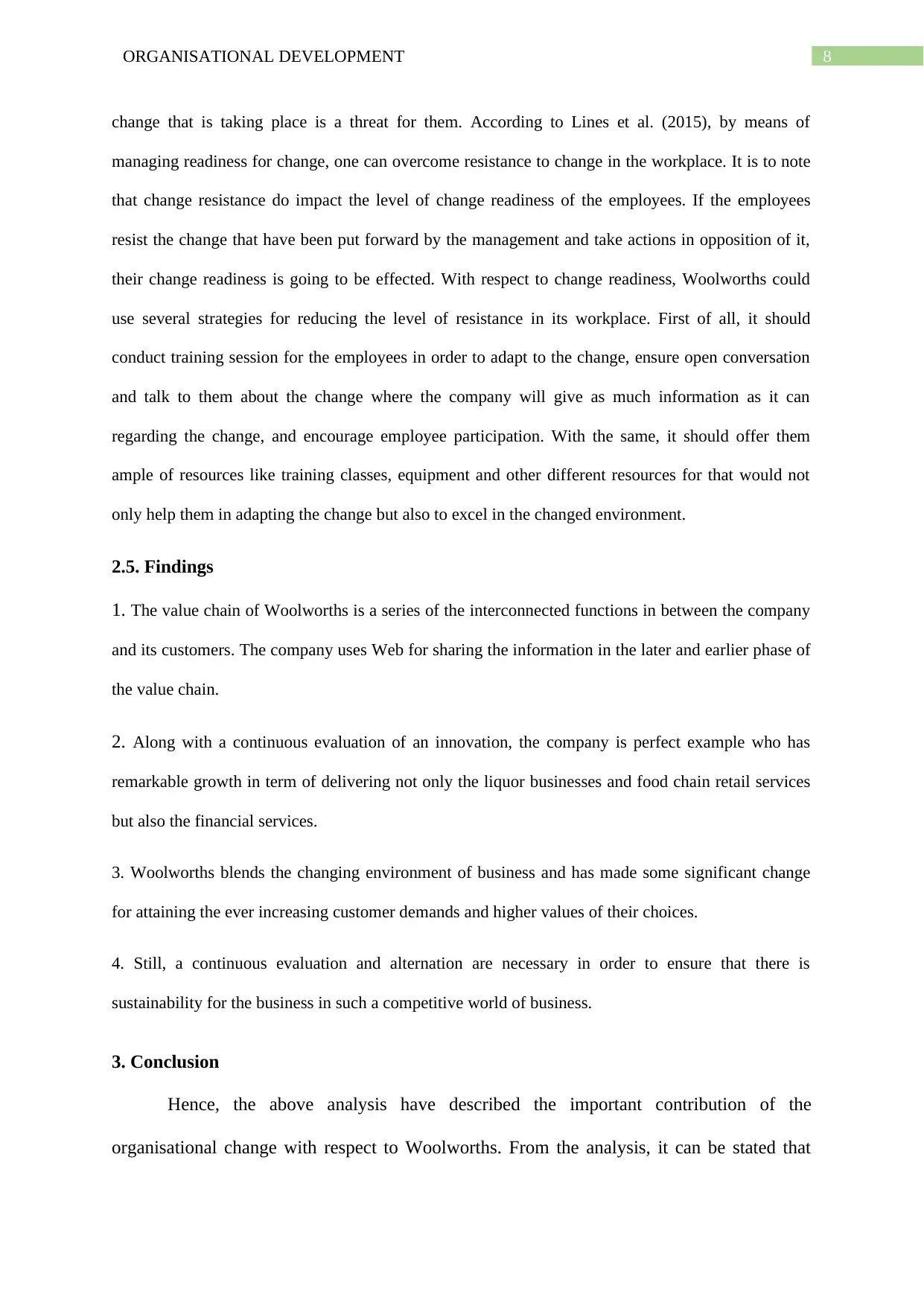
8ORGANISATIONAL DEVELOPMENT
change that is taking place is a threat for them. According to Lines et al. (2015), by means of
managing readiness for change, one can overcome resistance to change in the workplace. It is to note
that change resistance do impact the level of change readiness of the employees. If the employees
resist the change that have been put forward by the management and take actions in opposition of it,
their change readiness is going to be effected. With respect to change readiness, Woolworths could
use several strategies for reducing the level of resistance in its workplace. First of all, it should
conduct training session for the employees in order to adapt to the change, ensure open conversation
and talk to them about the change where the company will give as much information as it can
regarding the change, and encourage employee participation. With the same, it should offer them
ample of resources like training classes, equipment and other different resources for that would not
only help them in adapting the change but also to excel in the changed environment.
2.5. Findings
1. The value chain of Woolworths is a series of the interconnected functions in between the company
and its customers. The company uses Web for sharing the information in the later and earlier phase of
the value chain.
2. Along with a continuous evaluation of an innovation, the company is perfect example who has
remarkable growth in term of delivering not only the liquor businesses and food chain retail services
but also the financial services.
3. Woolworths blends the changing environment of business and has made some significant change
for attaining the ever increasing customer demands and higher values of their choices.
4. Still, a continuous evaluation and alternation are necessary in order to ensure that there is
sustainability for the business in such a competitive world of business.
3. Conclusion
Hence, the above analysis have described the important contribution of the
organisational change with respect to Woolworths. From the analysis, it can be stated that
change that is taking place is a threat for them. According to Lines et al. (2015), by means of
managing readiness for change, one can overcome resistance to change in the workplace. It is to note
that change resistance do impact the level of change readiness of the employees. If the employees
resist the change that have been put forward by the management and take actions in opposition of it,
their change readiness is going to be effected. With respect to change readiness, Woolworths could
use several strategies for reducing the level of resistance in its workplace. First of all, it should
conduct training session for the employees in order to adapt to the change, ensure open conversation
and talk to them about the change where the company will give as much information as it can
regarding the change, and encourage employee participation. With the same, it should offer them
ample of resources like training classes, equipment and other different resources for that would not
only help them in adapting the change but also to excel in the changed environment.
2.5. Findings
1. The value chain of Woolworths is a series of the interconnected functions in between the company
and its customers. The company uses Web for sharing the information in the later and earlier phase of
the value chain.
2. Along with a continuous evaluation of an innovation, the company is perfect example who has
remarkable growth in term of delivering not only the liquor businesses and food chain retail services
but also the financial services.
3. Woolworths blends the changing environment of business and has made some significant change
for attaining the ever increasing customer demands and higher values of their choices.
4. Still, a continuous evaluation and alternation are necessary in order to ensure that there is
sustainability for the business in such a competitive world of business.
3. Conclusion
Hence, the above analysis have described the important contribution of the
organisational change with respect to Woolworths. From the analysis, it can be stated that
⊘ This is a preview!⊘
Do you want full access?
Subscribe today to unlock all pages.

Trusted by 1+ million students worldwide
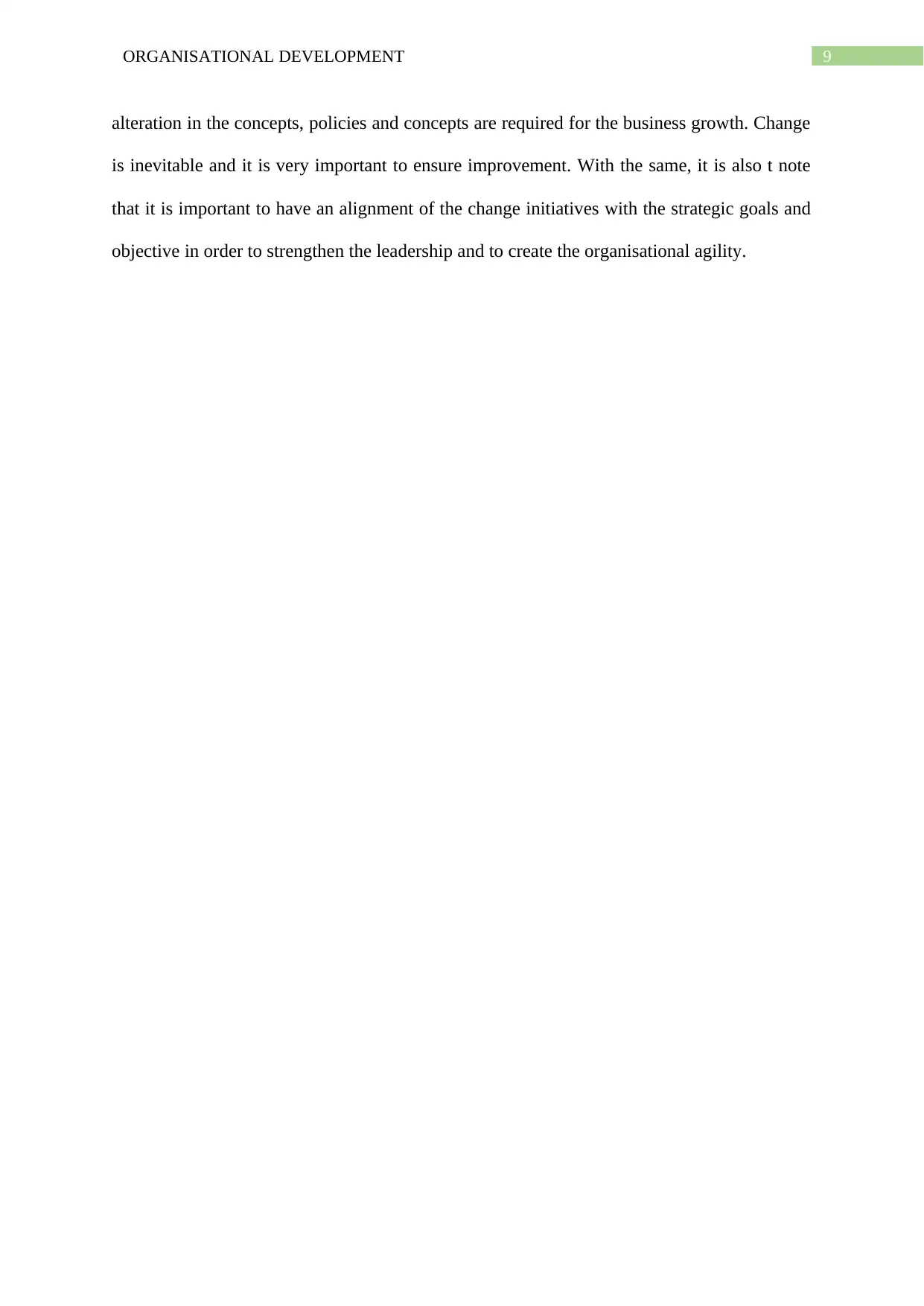
9ORGANISATIONAL DEVELOPMENT
alteration in the concepts, policies and concepts are required for the business growth. Change
is inevitable and it is very important to ensure improvement. With the same, it is also t note
that it is important to have an alignment of the change initiatives with the strategic goals and
objective in order to strengthen the leadership and to create the organisational agility.
alteration in the concepts, policies and concepts are required for the business growth. Change
is inevitable and it is very important to ensure improvement. With the same, it is also t note
that it is important to have an alignment of the change initiatives with the strategic goals and
objective in order to strengthen the leadership and to create the organisational agility.
Paraphrase This Document
Need a fresh take? Get an instant paraphrase of this document with our AI Paraphraser
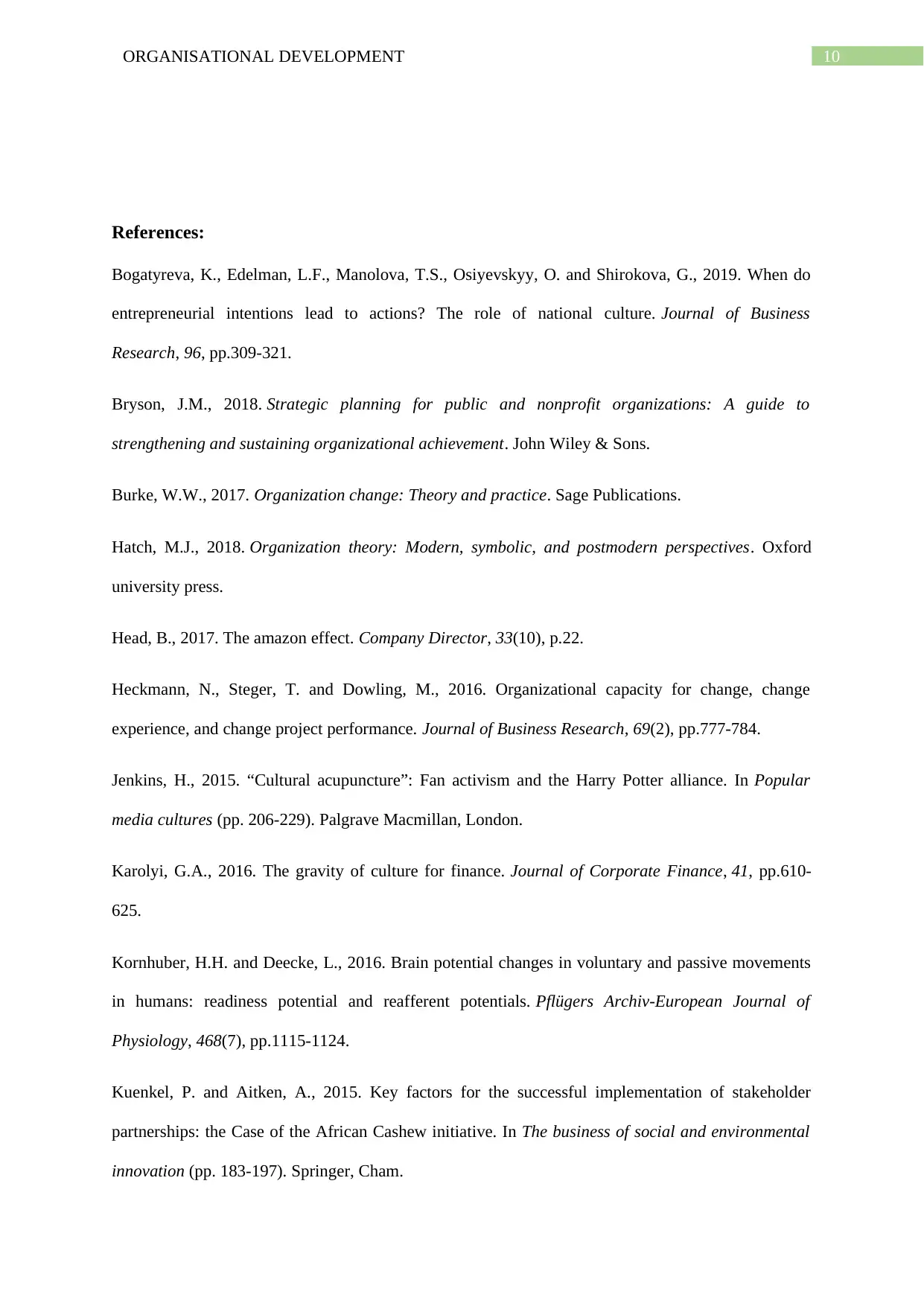
10ORGANISATIONAL DEVELOPMENT
References:
Bogatyreva, K., Edelman, L.F., Manolova, T.S., Osiyevskyy, O. and Shirokova, G., 2019. When do
entrepreneurial intentions lead to actions? The role of national culture. Journal of Business
Research, 96, pp.309-321.
Bryson, J.M., 2018. Strategic planning for public and nonprofit organizations: A guide to
strengthening and sustaining organizational achievement. John Wiley & Sons.
Burke, W.W., 2017. Organization change: Theory and practice. Sage Publications.
Hatch, M.J., 2018. Organization theory: Modern, symbolic, and postmodern perspectives. Oxford
university press.
Head, B., 2017. The amazon effect. Company Director, 33(10), p.22.
Heckmann, N., Steger, T. and Dowling, M., 2016. Organizational capacity for change, change
experience, and change project performance. Journal of Business Research, 69(2), pp.777-784.
Jenkins, H., 2015. “Cultural acupuncture”: Fan activism and the Harry Potter alliance. In Popular
media cultures (pp. 206-229). Palgrave Macmillan, London.
Karolyi, G.A., 2016. The gravity of culture for finance. Journal of Corporate Finance, 41, pp.610-
625.
Kornhuber, H.H. and Deecke, L., 2016. Brain potential changes in voluntary and passive movements
in humans: readiness potential and reafferent potentials. Pflügers Archiv-European Journal of
Physiology, 468(7), pp.1115-1124.
Kuenkel, P. and Aitken, A., 2015. Key factors for the successful implementation of stakeholder
partnerships: the Case of the African Cashew initiative. In The business of social and environmental
innovation (pp. 183-197). Springer, Cham.
References:
Bogatyreva, K., Edelman, L.F., Manolova, T.S., Osiyevskyy, O. and Shirokova, G., 2019. When do
entrepreneurial intentions lead to actions? The role of national culture. Journal of Business
Research, 96, pp.309-321.
Bryson, J.M., 2018. Strategic planning for public and nonprofit organizations: A guide to
strengthening and sustaining organizational achievement. John Wiley & Sons.
Burke, W.W., 2017. Organization change: Theory and practice. Sage Publications.
Hatch, M.J., 2018. Organization theory: Modern, symbolic, and postmodern perspectives. Oxford
university press.
Head, B., 2017. The amazon effect. Company Director, 33(10), p.22.
Heckmann, N., Steger, T. and Dowling, M., 2016. Organizational capacity for change, change
experience, and change project performance. Journal of Business Research, 69(2), pp.777-784.
Jenkins, H., 2015. “Cultural acupuncture”: Fan activism and the Harry Potter alliance. In Popular
media cultures (pp. 206-229). Palgrave Macmillan, London.
Karolyi, G.A., 2016. The gravity of culture for finance. Journal of Corporate Finance, 41, pp.610-
625.
Kornhuber, H.H. and Deecke, L., 2016. Brain potential changes in voluntary and passive movements
in humans: readiness potential and reafferent potentials. Pflügers Archiv-European Journal of
Physiology, 468(7), pp.1115-1124.
Kuenkel, P. and Aitken, A., 2015. Key factors for the successful implementation of stakeholder
partnerships: the Case of the African Cashew initiative. In The business of social and environmental
innovation (pp. 183-197). Springer, Cham.
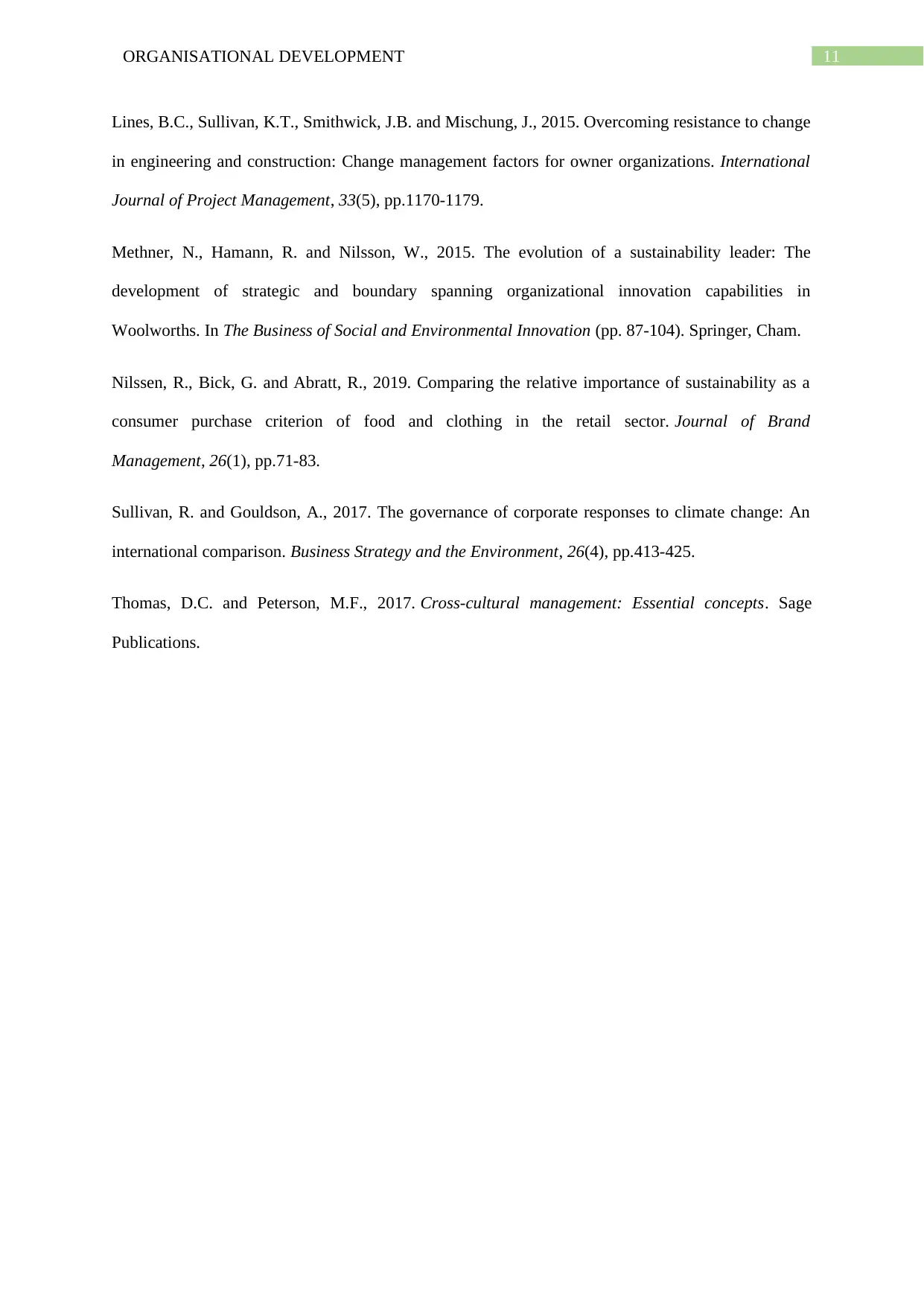
11ORGANISATIONAL DEVELOPMENT
Lines, B.C., Sullivan, K.T., Smithwick, J.B. and Mischung, J., 2015. Overcoming resistance to change
in engineering and construction: Change management factors for owner organizations. International
Journal of Project Management, 33(5), pp.1170-1179.
Methner, N., Hamann, R. and Nilsson, W., 2015. The evolution of a sustainability leader: The
development of strategic and boundary spanning organizational innovation capabilities in
Woolworths. In The Business of Social and Environmental Innovation (pp. 87-104). Springer, Cham.
Nilssen, R., Bick, G. and Abratt, R., 2019. Comparing the relative importance of sustainability as a
consumer purchase criterion of food and clothing in the retail sector. Journal of Brand
Management, 26(1), pp.71-83.
Sullivan, R. and Gouldson, A., 2017. The governance of corporate responses to climate change: An
international comparison. Business Strategy and the Environment, 26(4), pp.413-425.
Thomas, D.C. and Peterson, M.F., 2017. Cross-cultural management: Essential concepts. Sage
Publications.
Lines, B.C., Sullivan, K.T., Smithwick, J.B. and Mischung, J., 2015. Overcoming resistance to change
in engineering and construction: Change management factors for owner organizations. International
Journal of Project Management, 33(5), pp.1170-1179.
Methner, N., Hamann, R. and Nilsson, W., 2015. The evolution of a sustainability leader: The
development of strategic and boundary spanning organizational innovation capabilities in
Woolworths. In The Business of Social and Environmental Innovation (pp. 87-104). Springer, Cham.
Nilssen, R., Bick, G. and Abratt, R., 2019. Comparing the relative importance of sustainability as a
consumer purchase criterion of food and clothing in the retail sector. Journal of Brand
Management, 26(1), pp.71-83.
Sullivan, R. and Gouldson, A., 2017. The governance of corporate responses to climate change: An
international comparison. Business Strategy and the Environment, 26(4), pp.413-425.
Thomas, D.C. and Peterson, M.F., 2017. Cross-cultural management: Essential concepts. Sage
Publications.
⊘ This is a preview!⊘
Do you want full access?
Subscribe today to unlock all pages.

Trusted by 1+ million students worldwide
1 out of 12
Related Documents
Your All-in-One AI-Powered Toolkit for Academic Success.
+13062052269
info@desklib.com
Available 24*7 on WhatsApp / Email
![[object Object]](/_next/static/media/star-bottom.7253800d.svg)
Unlock your academic potential
Copyright © 2020–2025 A2Z Services. All Rights Reserved. Developed and managed by ZUCOL.





